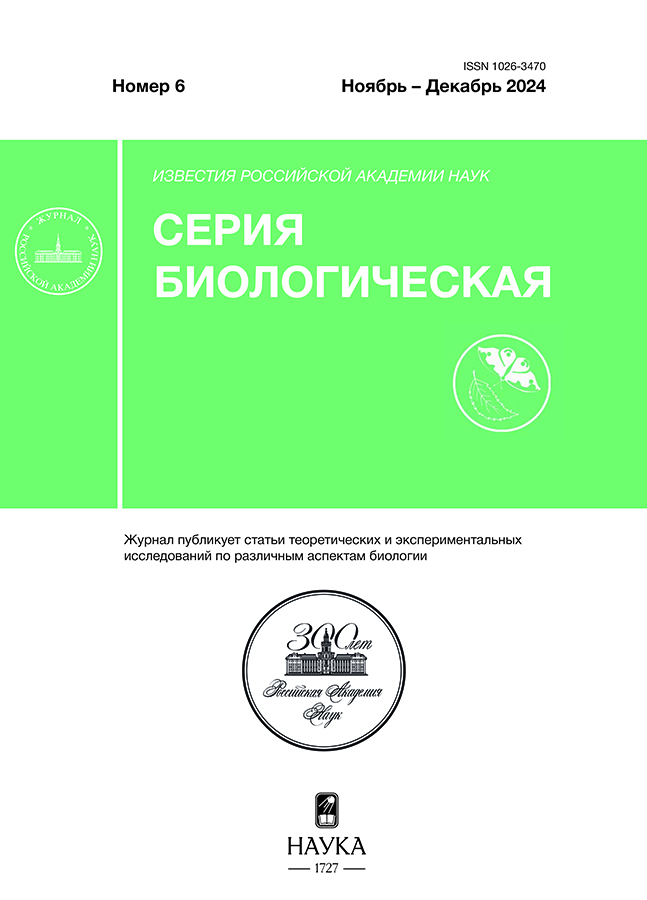Effect of water temperature on the size-age structure of the population of Hydrobia acuta Black Sea molluscs and on invasion with Gynaecotyla adunca parthenitae
- 作者: Belousova Y.V.1, Makarov M.V.1, Lyakh A.M.1
-
隶属关系:
- Kovalevsky Institute of Biology of the Southern Seas of RAS
- 期: 编号 6 (2024)
- 页面: 754-760
- 栏目: ZOOLOGY
- URL: https://cardiosomatics.ru/1026-3470/article/view/647839
- DOI: https://doi.org/10.31857/S1026347024060085
- EDN: https://elibrary.ru/ukosnm
- ID: 647839
如何引用文章
详细
In the present work, the influence of water temperature on the size-age structure and size of the population of Hydrobia acuta molluscs and their invasion with parthenites of the microphallid trematode Gynaecotyla adunca in Kazachya Bay (Black Sea) was studied. A positive correlation between the indicators of invasion extensity and the size, abundance of molluscs and water temperature was revealed. It was found that the seasonal dynamics of G. adunca parthenites abundance clearly distinguishes the periods of mass infesction of molluscs, which are graphically displayed by two peaks – in July and November. It was confirmed that the life cycle of the Black Sea molluscs Hydrobia acuta proceeds similarly to that of Mediterranean individuals
全文:
作者简介
Y. Belousova
Kovalevsky Institute of Biology of the Southern Seas of RAS
编辑信件的主要联系方式.
Email: julls.belousova@gmail.com
俄罗斯联邦, Sevastopol
M. Makarov
Kovalevsky Institute of Biology of the Southern Seas of RAS
Email: julls.belousova@gmail.com
俄罗斯联邦, Sevastopol
A. Lyakh
Kovalevsky Institute of Biology of the Southern Seas of RAS
Email: julls.belousova@gmail.com
俄罗斯联邦, Sevastopol
参考
- Белоусова Ю.В., Макаров М. В., Лях А. М. Влияние температуры воды на зараженность черноморских моллюсков Hydrobia acuta (Draparnaud, 1805) партенитами трематод Cryptocotyle lingua // Биология внутренних вод. 2024 (в печати)
- Быховская-Павловская И.Е. Паразитологическое исследование рыб. Ленинрад: Наука,1969. 108 с.
- Дмитриева Е. В., Белофастова И. П., Корнийчук Ю.М., Мачкевский В. К., Пронькина Н. В., Полякова Т. А. Гельминтофауна рыб Карадагского природного заповедника // Сборник научных трудов, посвящ. биологической станции и 30-летию Карадагского природного заповедника НАНУ. Севастополь, 2009. 150 с.
- Макаров М. В. Современное состояние малакофауны рыхлых грунтов в вершинной части бухты Казачьей (Черное море) // Экологическая безопасность прибрежной и шельфовой зон моря. 2020. № 1. С. 119–130.
- Миронов О. Г., Кирюхина Л. Н., Алемов С. В. Экологическая характеристика бухты Казачья (Черное море) // Экология моря. 2002. Вып. 61. С. 85–89.
- Котельянец Е. А., Гуров К. И., Тихонова Е. А., Соловьева О. В. Некоторые геохимические показатели донных отложений прибрежной акватории под влиянием антропогенного фактора (на примере бухты Казачья, г. Севастополь) // Вестник Удмуртского университета. Серия Биология. Науки о земле. 2017. Т. 27. № 1. С. 5–13.
- Пронькина Н. В., Полякова Т. А. Гельминтофауна рыб акватории прибрежно-аквального комплекса заказника «Бухта Казачья» // Материалы VII Международной научно-практической конференции. Симферополь. 2013. C. 365–370
- Чухчин В. Д. Жизненный цикл и рост Hydrobia acuta (Drap) и Hydrobia ventrosa (Mont) в Черном море // Биология моря. 1976. Вып. 37. С. 85–90.
- Чухчин В. Д. Экология брюхоногих моллюсков Черного моря. Киев: Наукова думка, 1984. 176 с.
- Belousova Yu.V. The First Data on Larvae of Trematodes from the Gastropod Hydrobia acuta in the Black Sea // Biol. Bull. Russ. Acad, Sci. 2022. V. 49. №. 1. P. 21–28. https://doi.org/10.1134/S1062359022020042
- Britton R. H. Life cycle and production of Hydrobia acuta Drap. (Gastropoda: Prosobranchia) in a hypersaline coastal lagoon // Hydrobiologia. 1985. V. 122. P. 219–230. https://doi.org/10.1007/BF00018282
- Kube S., Kube J., Bick A. Component community of larval trematodes in the mudsnail Hydrobia ventrosa: temporal variations in prevalence in relation to host life history // J,Parasitol. 2002. V. 88. № 4. P. 730–737. https://doi.org/10.1645/0022-3395(2002)088[0730:CCOLTI]2.0.CO;2
- Mouritsen K. N., Jensen T., Jensen K. T. Parasites on an intertidal Corophium-bed: Factors determining the phenology of microphallid trematodes in the intermediate host populations of the mud snail Hydrobia ulvae and the amphipod Corophium volutator // Hydrobiologia. 1997. V. 355. P. 61–70. https://doi.org/10.1023/A:1003067104516
- Pohley W. J. Relationships among three species of Littorina and their larval digenea. Mar. Biol. 1976. V. 37. P. 179–186. https://doi.org/10.1007/BF00389127
- Sindermann C. J., Farrin A. E. Ecological studies of Cryptocotyle lingua (Trematoda: Heterophyidae) whose larvae cause ‘‘pigment spots’’ of marine fish // Ecol Soc Am. 1962. V. 43. P. 69–75. https://doi.org/10.2307/1932041
- Werding B. Morphologie, Entwicklung und Okologie digener Trematoden-Larven der Strandschnecke Littorina littorea. Mar. Biol. 1969. V. 3. P. 306–333. https://doi.org/10.1007/BF00698861
补充文件













